A 30-minute bodyweight workout is a time-efficient way to build strength, improve endurance, and boost flexibility without equipment. Ideal for busy schedules, it engages the full body, promoting overall fitness and well-being. Perfect for home or travel, these routines are adaptable to all fitness levels, making them accessible and effective for anyone. Discover how to maximize your time with structured, goal-oriented exercises that deliver results in just 30 minutes daily.
Benefits of Bodyweight Training
Bodyweight training offers numerous benefits, making it a versatile and effective fitness choice. It improves strength, endurance, and flexibility without requiring equipment, making it accessible anywhere. Regular practice enhances muscle tone, boosts metabolism, and increases overall physical fitness. Additionally, bodyweight exercises promote better posture, balance, and coordination. They are low-impact, reducing the risk of injury compared to high-intensity workouts. Bodyweight training is also cost-effective and time-efficient, perfect for busy schedules. It caters to all fitness levels, with modifications available for beginners and challenges for advanced individuals. Incorporating bodyweight workouts into your routine can lead to significant health improvements and long-term wellness. They are a sustainable way to stay active and achieve fitness goals consistently.
Convenience of a 30-Minute Workout
A 30-minute workout offers unmatched convenience, fitting seamlessly into even the busiest schedules. It eliminates the need for gym memberships or equipment, allowing you to train anywhere, whether at home, in a park, or while traveling. This time-efficient approach ensures you can prioritize fitness without sacrificing other responsibilities. Bodyweight exercises are adaptable to all fitness levels, making them ideal for beginners and experienced individuals alike. A well-structured 30-minute routine can combine strength, cardio, and flexibility, providing a full-body workout. Its brevity makes it easier to stay consistent, while the lack of equipment ensures accessibility. This format is perfect for those seeking a practical and efficient way to maintain or improve their physical health without compromising time or resources.
Setting Fitness Goals for a 30-Minute Routine
Setting clear fitness goals is essential for maximizing the effectiveness of a 30-minute bodyweight workout. Start by identifying specific, measurable objectives, such as improving strength, increasing flexibility, or enhancing cardiovascular endurance. SMART goals—specific, measurable, achievable, relevant, and time-bound—help maintain focus and motivation. For example, aim to perform a certain number of push-ups or hold a plank for a longer duration. Adjust your goals as your fitness level progresses, ensuring they remain challenging yet attainable. Tracking progress and celebrating milestones will keep you motivated and committed to your routine; Regularly assessing and updating your goals ensures continuous improvement and long-term success in your fitness journey.

Understanding Bodyweight Exercises
Bodyweight exercises use your own weight as resistance to build strength, flexibility, and endurance. They are versatile, effective, and suitable for all fitness levels, enhancing overall physical fitness.
Types of Bodyweight Exercises
Bodyweight exercises encompass a wide range of movements that target different muscle groups and fitness goals. They can be categorized into upper body, lower body, core, and full-body exercises. Push-ups, pull-ups, and tricep dips are excellent for building upper body strength, while squats, lunges, and glute bridges focus on the legs and hips. Planks, Russian twists, and bicycle crunches are ideal for core stability. Full-body exercises like burpees, jump squats, and mountain climbers combine strength and cardio for a comprehensive workout. These exercises are versatile, requiring minimal or no equipment, making them accessible for anyone. They can also be modified to suit different fitness levels, ensuring a challenging and effective workout for everyone.
Key Principles of Effective Bodyweight Training
Effective bodyweight training relies on several key principles to ensure safety, efficiency, and progress. Proper form and technique are essential to prevent injuries and maximize results. Progressive overload, gradually increasing difficulty through variations or volume, helps build strength and endurance. Understanding movement patterns and planes of motion ensures a balanced workout. Breathing techniques, such as exhaling during exertion, enhance performance and reduce strain. Tempo and pacing play a role in optimizing each exercise’s effectiveness. Incorporating isometric holds can improve stability and strength. These principles, when applied consistently, create a foundation for a safe and efficient 30-minute bodyweight workout, adaptable to all fitness levels.
Importance of Proper Form and Technique
Proper form and technique are critical for maximizing the effectiveness of a 30-minute bodyweight workout while minimizing the risk of injury. When exercises are performed correctly, they target the intended muscle groups, ensuring optimal engagement and results. Poor form can lead to strain or injury, undermining progress and potentially sidelining you for weeks. By focusing on controlled movements and maintaining proper alignment, you enhance strength, flexibility, and overall performance. Additionally, good technique allows for better progression to more challenging variations as you advance. Prioritizing form fosters a safer, more efficient workout, enabling you to achieve your fitness goals consistently.

Designing Your 30-Minute Workout
A well-structured 30-minute bodyweight workout balances warm-up, exercise sequences, and cool-down, ensuring efficiency and progression while maintaining engagement and focus throughout the routine.
Warm-Up Routine for Bodyweight Training
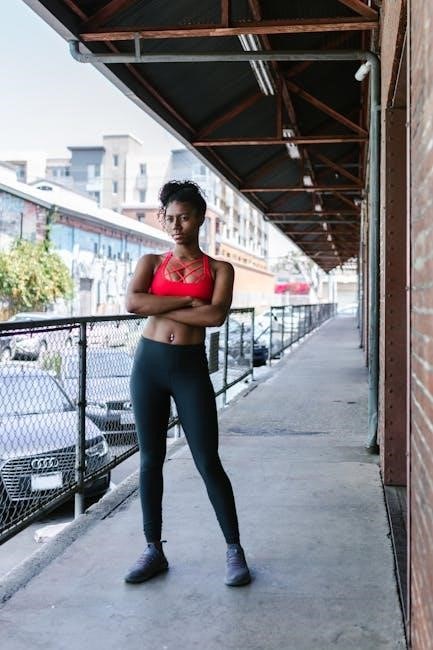
A dynamic warm-up is crucial for preparing the body for a 30-minute bodyweight workout. Start with 5 minutes of light cardio, such as jumping jacks or arm circles, to elevate heart rate and increase blood flow. Incorporate dynamic stretches like leg swings, hip circles, and torso twists to activate major muscle groups.Finish with gentle muscle activations, such as glute bridges or push-up variations, to prime the body for movement. Keep the warm-up engaging and consistent to ensure optimal preparation and injury prevention. This routine sets the foundation for a productive and safe workout, aligning with the structure outlined in your 30-minute bodyweight workout PDF.
Structuring the 30-Minute Workout
A well-structured 30-minute bodyweight workout ensures efficiency and effectiveness. Begin with a 5-minute warm-up, followed by 20 minutes of targeted exercises divided into segments: upper body, lower body, core, and cardio. Allocate 5 minutes per segment to maintain focus and intensity. For example, dedicate the first 5 minutes to push-ups, squats, or lunges, then transition to planks, mountain climbers, or burpees. Finish with a 5-minute cool-down and stretching to promote recovery. This structure maximizes time, targets all major muscle groups, and incorporates cardiovascular elements for a full-body workout. Adjust the routine based on fitness levels and goals, as detailed in your 30-minute bodyweight workout PDF.
Cool-Down and Stretching Exercises
A proper cool-down is essential after a 30-minute bodyweight workout to reduce muscle tension and prevent soreness. Start with gentle stretches for major muscle groups, such as hamstrings, quadriceps, and chest muscles. Incorporate static stretches, holding each for 20-30 seconds to promote flexibility. Include poses like child’s pose or seated forward folds to relax the lower back. Gentle neck rolls and shoulder stretches can relieve tension built during exercise. Finish with deep breathing exercises to calm the mind and transition smoothly into a resting state. This routine ensures a smooth recovery and prepares the body for the next session. Detailed stretching sequences are outlined in your downloadable 30-minute bodyweight workout PDF.
Full-Body Workout Plan
A 30-minute full-body workout combines strength, cardio, and flexibility exercises. It targets all major muscle groups, ensuring a balanced and efficient routine. Details are in the PDF.
Upper Body Exercises
Lower Body Exercises
Lower body exercises in a 30-minute workout focus on building strength and endurance in the legs, hips, and glutes. Squats, lunges, and glute bridges are essential movements that target multiple muscle groups simultaneously. These exercises improve balance, coordination, and overall lower body stability. Incorporating variations like sumo squats or step-ups can add diversity to the routine. Calf raises and wall sits are great for isolating smaller muscle groups, ensuring a comprehensive workout. Proper form is crucial to avoid injury and maximize results. The PDF provides a structured sequence of lower body exercises, ensuring a well-rounded and effective 30-minute session. These exercises are designed to enhance both functional strength and athletic performance.
Lower body exercises are a cornerstone of a 30-minute bodyweight workout, targeting the legs, hips, and glutes. Squats and lunges are foundational movements that build strength and endurance. Glute bridges and step-ups are excellent for isolating the glutes and improving hip mobility. Variations like sumo squats and side lunges add diversity to the routine. Calf raises and wall sits are included to strengthen smaller muscle groups. These exercises enhance balance, coordination, and overall lower body stability. The PDF provides a structured sequence to ensure a comprehensive workout, focusing on functional strength and athletic performance. Proper form is emphasized to maximize results and prevent injury, making the routine accessible and effective for all fitness levels.
Core and Stability Exercises
Core and stability exercises are essential for improving posture, balance, and overall athletic performance. Planks, bird dogs, and Russian twists target the abdominals and obliques, while variations like side planks and hollow body holds challenge stability. Stability exercises such as single-leg stands, balance poses, and dynamic movements like bicycle crunches and superman holds enhance core engagement. These exercises strengthen the muscles around the spine and pelvis, improving functional strength. The 30-minute bodyweight workout PDF includes a selection of core exercises designed to build endurance and stability. Variations cater to different fitness levels, ensuring progression and engagement. Proper form is emphasized to maximize results and prevent injury, making core training accessible and effective for everyone.
Cardiovascular Elements
Incorporating cardiovascular exercises into your 30-minute bodyweight workout enhances heart health, boosts endurance, and accelerates calorie burn. High-intensity moves like jumping jacks, burpees, and mountain climbers are excellent for raising your heart rate. Plank jacks and squat jumps also provide a cardio challenge while engaging multiple muscle groups. These exercises can be integrated into circuits or intervals to maximize efficiency. The 30-minute bodyweight workout PDF includes cardio-focused routines designed to improve stamina and promote weight management. By combining strength and cardio, you achieve a well-rounded fitness routine. Consistency in these exercises will enhance your overall cardiovascular fitness and support long-term health benefits. The plan ensures a balanced approach to fitness, keeping workouts dynamic and engaging.
Incorporating Variations and Modifications
Modify exercises to suit fitness levels by adjusting intensity, reps, or complexity. Use props or reduce ranges of motion for accessibility. Progressions challenge advanced individuals.
Beginner-Friendly Modifications
For those starting out, modify exercises to make them more accessible while maintaining effectiveness. Reduce intensity by performing fewer repetitions or sets, and incorporate shorter ranges of motion. Use props like chairs or walls for support, such as in knee push-ups or assisted squats. Substitute complex movements with simpler alternatives, like swapping burpees for squats or Lunges. Decrease the overall volume by shortening rest periods or focusing on fewer exercises. Prioritize proper form to prevent injuries and build a strong foundation. Remember, modifications are temporary adjustments to help you progress safely and confidently. Download the 30-Minute Bodyweight Workout PDF for tailored guidance and examples. Consistency will lead to progress, so embrace the journey and enjoy the process of getting stronger!
Intermediate-Level Progressions
Once comfortable with the basics, intermediate-level progressions can enhance intensity and challenge. Increase difficulty by modifying exercises, such as elevating your feet during push-ups or transitioning to single-leg squats. Incorporate tempo changes, like slower descents or pauses, to increase time under tension. Add complexity by combining movements, such as turning squats into squat-to-lunges or push-ups into spiderman variations. Experiment with dynamic movements like jump squats or burpees to boost explosiveness. For core exercises, try single-arm planks or hollow-body holds. These adjustments keep workouts engaging and ensure continued progress. Download the 30-Minute Bodyweight Workout PDF for step-by-step instructions and examples tailored to your fitness level. Challenge yourself to push beyond your limits while maintaining proper form and technique.

Advanced Challenges for Experienced Individuals
For experienced individuals, advanced challenges can push workouts to new heights. Incorporate complex movements like single-arm handstand push-ups, deficit pull-ups, or single-leg pistol squats. Add tempo variations, such as 3-seconds down, 2-seconds hold, and explosive up phases. Introduce plyometric exercises like clap push-ups or box jumps to boost power. For core, try dynamic movements like dragon flags or single-arm hollow-body holds. Increase duration or reduce rest periods to enhance endurance. Experiment with unilateral exercises to address strength imbalances. These advanced techniques ensure continued growth and prevent plateaus. The 30-Minute Bodyweight Workout PDF provides detailed progressions to help experienced individuals refine their skills and take their fitness to the next level with precision and safety.
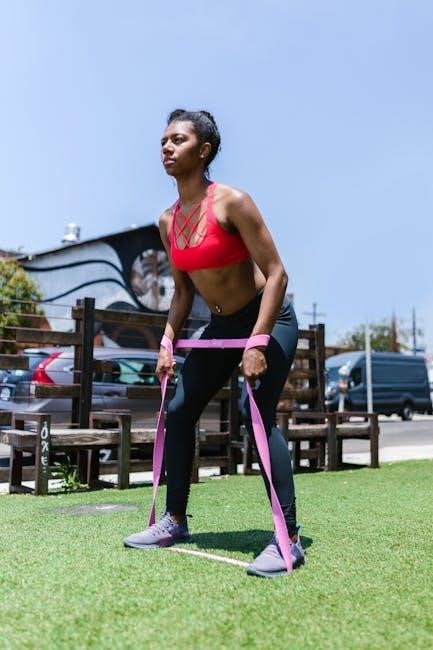
Progression and Scaling the Workout
Progression and scaling are crucial for continuous improvement in a 30-minute bodyweight workout. Gradually increase reps, sets, or intensity to challenge muscles and avoid plateaus safely.
Increasing Difficulty Over Time
As you progress, gradually increase the intensity of your 30-minute bodyweight workout by adding reps, sets, or reducing rest periods. Incorporate more challenging variations, such as single-leg squats or plyometric movements, to target muscles differently. Time-based exercises, like holding planks longer or performing more reps within the same timeframe, can also boost difficulty. Advanced individuals might introduce equipment like resistance bands or weighted vests to enhance resistance. Progressions should be implemented every 1-2 weeks, allowing your body to adapt safely. Track improvements to ensure consistent growth without overtraining. Always prioritize proper form to prevent injuries and maintain the effectiveness of each exercise. Stay consistent and celebrate small victories to stay motivated. Adjustments should align with your fitness level and goals for sustainable progress. Balancing intensity with recovery is key to long-term success.
Setting Realistic Progress Goals
Setting realistic progress goals is essential for maintaining motivation and tracking improvement in your 30-minute bodyweight workout. Start by identifying specific, measurable objectives, such as increasing the number of push-ups or reducing rest time between sets. Break larger goals into smaller, achievable milestones to avoid discouragement. Use a weekly or bi-weekly timeframe to assess progress and adjust goals as needed. Celebrate small victories to stay motivated and remind yourself that consistency is key. Track your workouts in a journal or app to monitor advancements visually. Ensure goals align with your fitness level and lifestyle to maintain sustainability. By setting clear, attainable targets, you’ll stay focused and committed to your routine. Adjustments should reflect realistic expectations to foster long-term success and enjoyment of the process.
Tracking Your Improvement
Tracking your improvement in a 30-minute bodyweight workout is crucial for staying motivated and understanding your progress. Use a workout journal or mobile app to log each session, noting exercises, repetitions, and completion time. Regularly take progress photos or measurements to visualize physical changes. Celebrate small milestones, like mastering a challenging exercise or increasing endurance, to reinforce consistency. Adjust your routine based on tracked data to ensure continuous growth. Remember, progress isn’t always linear—focus on trends over time. Stay patient and committed, as consistent effort leads to long-term results. By monitoring your journey, you’ll gain clarity on what works best for your body and stay inspired to keep pushing forward.

Nutrition and Recovery
A balanced diet with proteins, carbs, and fats aids muscle repair and energy. Adequate recovery through rest and hydration supports muscle growth and performance.
Pre-Workout Nutrition Tips
Proper nutrition before a 30-minute bodyweight workout is essential for energy and performance. Aim to eat a balanced meal 1-3 hours prior, focusing on complex carbs, lean proteins, and healthy fats. Foods like whole grains, bananas, or a handful of nuts provide sustained energy. Avoid heavy, high-sugar meals that may cause discomfort. Stay hydrated with water or herbal teas to maintain optimal hydration levels. For an extra boost, consider a pre-workout snack rich in easily digestible nutrients, such as a protein smoothie or a piece of fruit. Timing and portion control are key to fuel your workout without feeling weighed down.
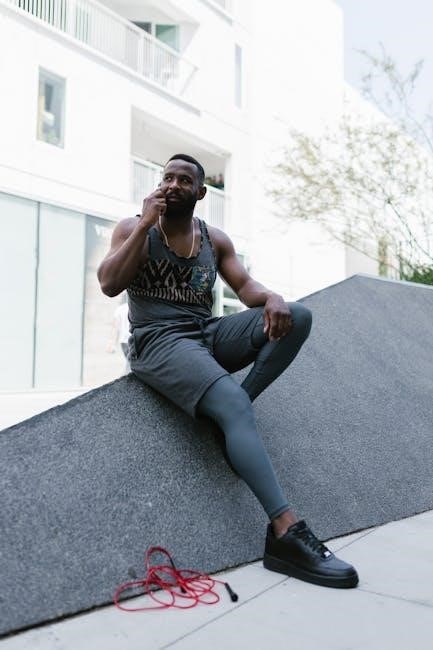
Post-Workout Recovery Strategies
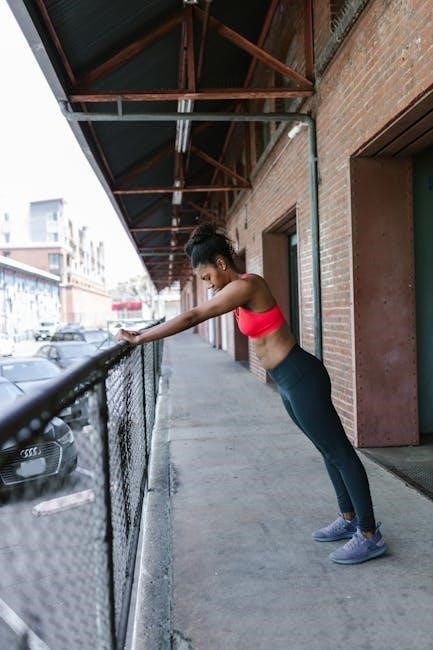
After completing your 30-minute bodyweight workout, prioritize recovery to repair muscles and replenish energy. Begin with static stretching or foam rolling to improve flexibility and reduce muscle tension. Rehydrate with water or a electrolyte-rich drink to restore lost fluids. Consume a balanced meal or snack within 30-60 minutes, combining carbohydrates, lean proteins, and healthy fats to aid muscle recovery. Avoid processed foods and opt for whole, nutrient-dense options instead. Ensure adequate rest and sleep (7-9 hours nightly) to support muscle repair and overall recovery. Consider incorporating light activities, such as walking, to promote blood flow without overexerting; A well-structured recovery routine enhances performance and reduces soreness for future workouts.
Hydration and Sleep for Optimal Results
Proper hydration and adequate sleep are essential for maximizing the benefits of your 30-minute bodyweight workout. Drinking enough water ensures optimal physical performance and supports recovery by transporting nutrients and removing waste products. Aim to hydrate before, during, and after your workout, with water being the best choice. Sleep plays a critical role in muscle recovery, hormonal balance, and mental clarity. Aim for 7-9 hours of quality sleep nightly to allow your body to repair and adapt. Poor hydration and insufficient sleep can hinder progress, while prioritizing both enhances energy levels, recovery, and overall performance. Make hydration and sleep cornerstones of your fitness routine for lasting results.
Staying Motivated and Consistent
Consistency is key to achieving fitness goals. Create a schedule, track progress, and stay inspired by celebrating small victories. Surround yourself with supportive people who encourage your journey and help maintain accountability. A positive mindset and clear goals will keep you motivated to show up daily for your 30-minute workouts. Remember, every effort brings you closer to your desired results;
Creating a Workout Schedule
Establishing a workout schedule is crucial for consistency. Plan specific days and times for your 30-minute workouts, ensuring they fit seamlessly into your daily routine. Start by identifying your most energetic periods and allocate those slots for exercise. Use a calendar or mobile app to set reminders and track your sessions. Aim for at least 4-5 workouts per week, with rest days in between to allow recovery. Vary your routine to avoid monotony, incorporating upper body, lower body, and core exercises on different days. Sticking to a structured schedule helps build discipline and ensures steady progress toward your fitness goals. Consistency is the backbone of successful bodyweight training.
Tracking Progress and Celebrating Milestones
Monitoring your progress and celebrating milestones is essential for staying motivated. Use a workout log or mobile app to track completed sessions, reps, and improvements. Take progress photos or measurements to visualize changes. Celebrate small victories, like mastering a challenging exercise or completing a week of workouts consistently. Reward yourself with non-food incentives, such as new workout gear or a relaxing bath. Sharing achievements with a friend or community can also boost morale. Recognizing progress, no matter how minor, fosters a sense of accomplishment and encourages continued effort. This practice helps maintain motivation and reinforces the habit of regular exercise.
Finding a Workout Buddy or Community
Having a workout buddy or joining a fitness community can greatly enhance your 30-minute bodyweight workout experience. A buddy provides accountability, motivation, and moral support, helping you stay consistent. Sharing goals and challenges fosters camaraderie and makes workouts more enjoyable. Online communities or local fitness groups offer additional encouragement and tips. Participating in group sessions can also introduce variety and healthy competition. Surrounding yourself with like-minded individuals creates a supportive environment, helping you stay committed to your fitness journey. Don’t hesitate to reach out to others who share your goals—this connection can significantly boost your motivation and overall success in achieving a healthier lifestyle.
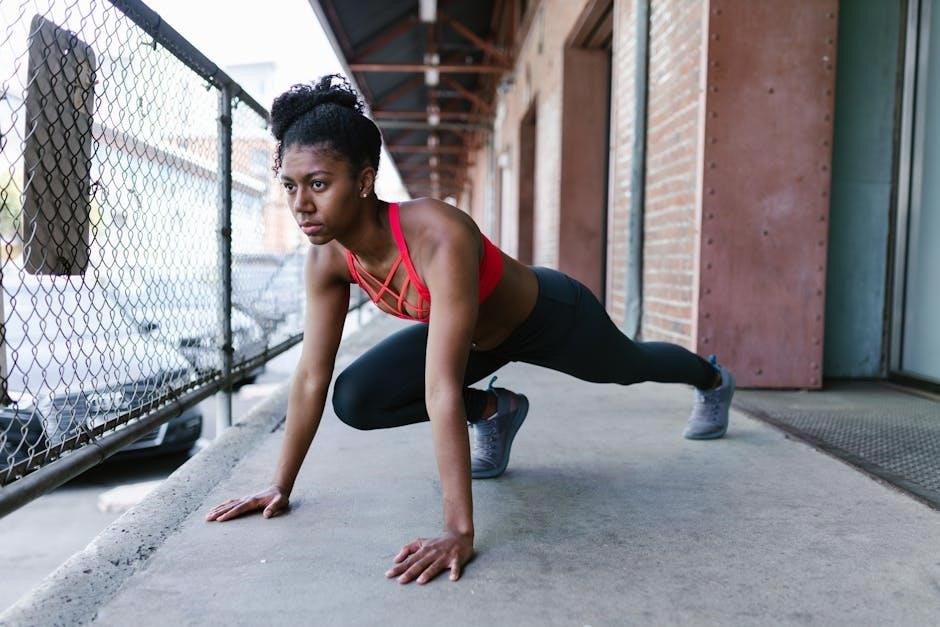
Final Thoughts and Next Steps
Congratulations on completing the guide to 30-minute bodyweight workouts! This efficient routine offers full-body fitness with minimal equipment. Download the PDF for quick access and start your transformative journey today.
Encouragement to Start Your Journey
Starting your fitness journey with a 30-minute bodyweight workout is a powerful first step toward a healthier, stronger you. Remember, consistency is key, and even small progress adds up over time. This convenient routine fits seamlessly into busy schedules, requiring no equipment and minimal space. Whether you’re a beginner or looking to maintain fitness, the downloadable PDF guide provides a clear, structured plan to follow. Don’t be intimidated—every workout is a victory. Celebrate small milestones, stay committed, and watch your body transform. With dedication, you’ll build strength, boost energy, and improve overall well-being. Download the guide, take the first step, and embrace the journey to a fitter, healthier life.
Resources for Further Learning
To deepen your understanding and enhance your 30-minute bodyweight workout, explore these valuable resources. Websites like ACE Fitness and American Council on Exercise offer detailed guides on bodyweight exercises. Apps such as Freeletics and JEFIT provide customizable workout plans and tracking tools. Books like The New Rules of Lifting and Convict Conditioning are excellent for learning progressive bodyweight training. Online communities like Reddit’s r/Fitness and r/BodyweightFitness are great for tips, motivation, and connecting with others. These resources will help you refine your technique, explore variations, and stay inspired on your fitness journey. Use them to maximize your results and continue growing stronger.
Downloadable 30-Minute Bodyweight Workout PDF
A downloadable 30-minute bodyweight workout PDF is a convenient tool to guide your fitness journey. This resource typically includes a structured workout plan, detailing exercises, sets, reps, and timing. It often features a warm-up routine, a sequence of upper body, lower body, and core exercises, followed by a cool-down. Many PDFs also provide nutritional tips and space for tracking progress. Designed to be printable and shareable, these guides are perfect for staying organized and motivated. Whether you’re a beginner or advanced, a downloadable PDF ensures you have a clear roadmap to follow. Download yours today and take the first step toward a consistent and effective workout routine.